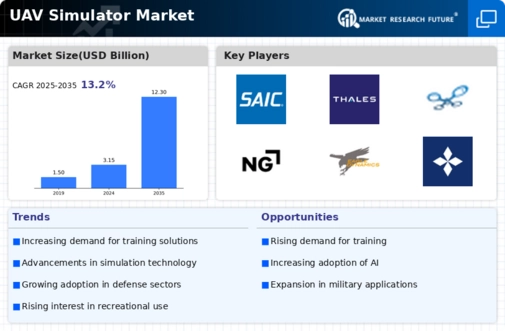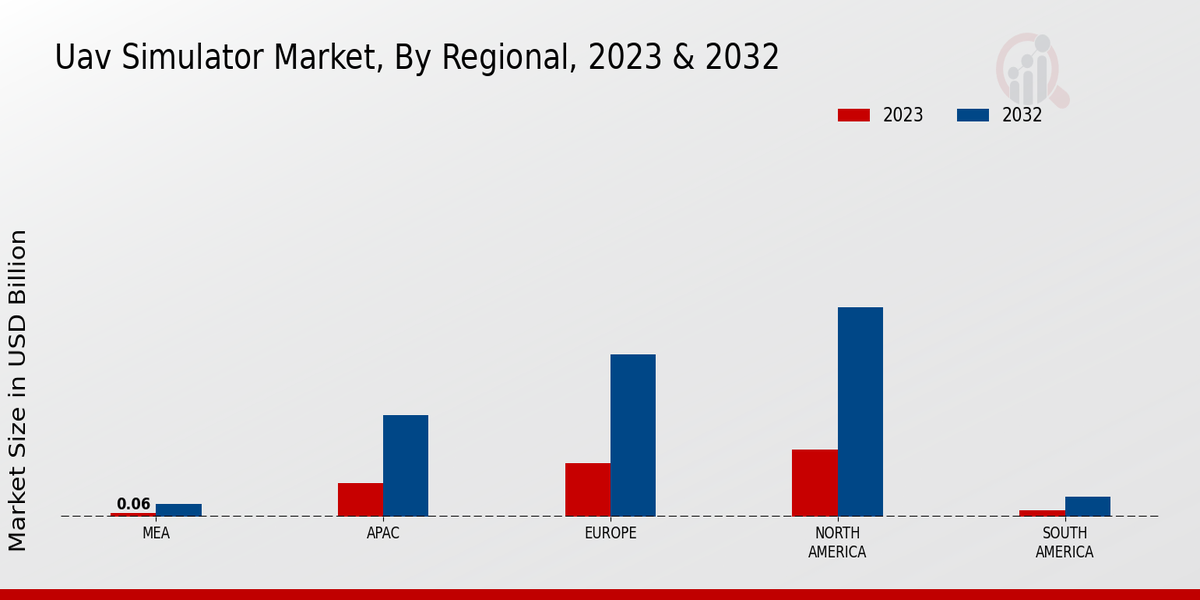Regulatory Compliance
Regulatory bodies worldwide are establishing stringent guidelines for UAV operations, which is significantly influencing the Global UAV Simulator Market Industry. Compliance with these regulations necessitates thorough training for UAV operators, thereby increasing the demand for effective simulation solutions. For example, the Federal Aviation Administration in the United States has implemented regulations that require UAV pilots to undergo specific training programs. This regulatory landscape is likely to drive investments in UAV simulators, as organizations strive to meet compliance standards while ensuring operational safety. Consequently, this factor is expected to contribute to a compound annual growth rate of 13.17% from 2025 to 2035.
Rising Demand for UAVs
The increasing adoption of unmanned aerial vehicles across various sectors is a key driver for the Global UAV Simulator Market Industry. Industries such as agriculture, logistics, and surveillance are increasingly utilizing UAVs for operational efficiency and cost reduction. This surge in UAV usage necessitates comprehensive training programs, which in turn drives the demand for advanced simulators. As organizations seek to minimize risks associated with UAV operations, the reliance on simulators for training purposes is expected to grow. This trend is anticipated to propel the market towards an estimated value of 12.3 USD Billion by 2035, indicating a robust growth trajectory.
Market Growth Projections
The Global UAV Simulator Market Industry is poised for substantial growth, with projections indicating a market value of 3.15 USD Billion in 2024 and an anticipated increase to 12.3 USD Billion by 2035. This growth trajectory suggests a compound annual growth rate of 13.17% from 2025 to 2035, highlighting the increasing reliance on UAV simulators for training and operational purposes. The expansion of the market is driven by various factors, including technological advancements, rising UAV adoption, and regulatory compliance. As the industry evolves, stakeholders are likely to invest in innovative simulation solutions to meet the growing demands of UAV operations.
Technological Advancements
The Global UAV Simulator Market Industry is experiencing rapid growth due to continuous technological advancements in simulation software and hardware. Enhanced graphics, real-time data processing, and improved user interfaces are making simulators more realistic and user-friendly. For instance, the integration of artificial intelligence and machine learning algorithms allows for adaptive learning environments, which can significantly enhance pilot training. As a result, the market is projected to reach 3.15 USD Billion in 2024, reflecting the increasing demand for sophisticated training solutions that can replicate complex flight scenarios. This trend is likely to contribute to the overall expansion of the industry.
Cost-Effectiveness of Simulators
The cost-effectiveness of UAV simulators is becoming increasingly apparent within the Global UAV Simulator Market Industry. Organizations are recognizing that simulators provide a safe and economical alternative to real-world flight training, which can be expensive and risky. By utilizing simulators, companies can conduct extensive training without incurring the costs associated with fuel, maintenance, and potential accidents. This financial advantage is particularly appealing to smaller enterprises and educational institutions, which may have limited budgets. As a result, the market is likely to witness sustained growth as more stakeholders adopt simulators as a primary training tool.
Growing Interest in Autonomous Systems
The rising interest in autonomous UAV systems is significantly impacting the Global UAV Simulator Market Industry. As industries explore the potential of fully autonomous operations, the need for specialized training programs becomes paramount. Simulators that can replicate autonomous flight scenarios are essential for preparing operators to manage these advanced systems effectively. This growing focus on autonomy is expected to drive innovation within the simulator market, leading to the development of more sophisticated training tools. As the demand for autonomous UAVs continues to rise, the simulator market is likely to expand in tandem, reflecting the evolving landscape of UAV technology.












